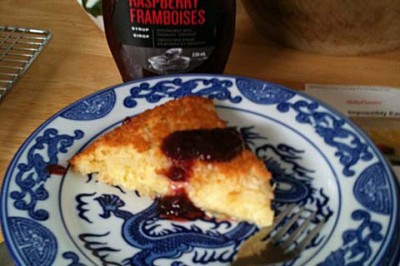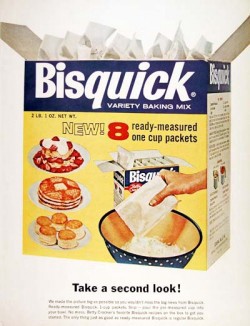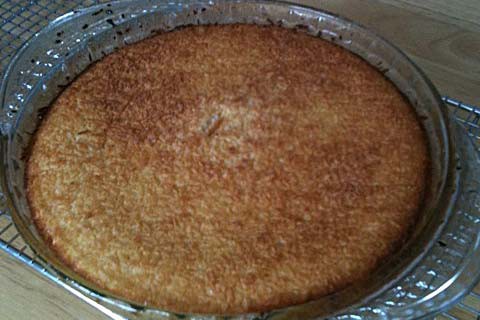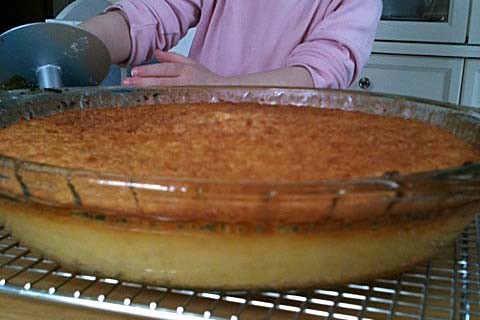Is Impossible Pie Impossible?
Is Impossible Pie Impossible?
by Stephany Aulenback

A series about recipes that may seem odd or outmoded and yet we’re curious to try!
“I’m going to make an Impossible Pie today,” I announced.
“What’s an Impossible Pie?” asked my six-year-old son, just as I hoped he would for the purpose of writing this introduction. “Is it a pie that no one’s ever made before?”
“No,” I said.
I was about to go on when my husband spoke up, “Well, when you think about it, every pie is a pie that no one’s ever made before…”
There was a brief silence.
My son later guessed that an Impossible Pie must be “very, very hard to make.” But this is not true, of course — as the Betty Crocker site adamantly points out, the impossible pie is impossibly easy. You don’t need to make a crust for it. Instead, you just mix up all the ingredients together — the ingredients for the filling and the crust — and while it cooks the pie forms its own crust. But would that really work? And how would it taste?

Impossible Pie first became widely known in the 1970s when it was printed on the backs of Bisquick boxes. The Bisquick mix — you may have seen the yellow boxes in a cupboard or two growing up — was reportedly invented in 1930 by a General Mills executive who, while on a journey by train, complimented the chef in the dining car on his fresh biscuits. The chef showed him how he pre-mixed shortening with the dry ingredients of flour, salt and baking powder and kept the mixture on ice in the train kitchen so he could prepare the biscuits very quickly. When they mass-marketed the idea, General Mills replaced the shortening with hydrogenated oil so that the product wouldn’t need to be refrigerated. At first they marketed it solely as a fast way to make biscuits, but soon, in an effort to increase sales, they started suggesting that consumers use it to make a variety of other foods, including pizza dough, pancakes, dumplings, cookies and, yes, you guessed it, even pie.
According to the excellent food-history website, The Food Timeline, the origins of Impossible Pie, are shrouded in mystery, as befits such an enigmatic creation. The first Impossible Pie recipe introduced by Bisquick was a coconut one; this indicates that the recipe might have originated in the South where coconut pies have long been popular. In a 1993 Houston Chronicle article, excerpted on the site, Marcia Copeland, then the “director of Betty Crocker foods and publications,” essentially confirms this, saying “we first saw the recipe for (crustless) coconut custard pies in Southern community cookbooks.”
The coconut version must have gone over very well because soon Bisquick was suggesting all sorts of variations, both savoury and sweet, including but certainly not limited to: Impossible Peach and Raspberry Pie, Impossible Chicken Pot Pie, Impossible Pumpkin Pecan Pie, and Impossible Roast Pepper and Feta Cheese Pie. Just think of something you could put into a pie and there’s an Impossible version of it out there.
At some point, sadly, the company started to refer to the pies as Impossibly Easy Pies, as evidenced by this cookbook. And today, as mentioned, anyone visiting the Betty Crocker website will find a compendium of Impossibly Easy Pie recipes, names that lack the alchemical flair of their predecessors. One can only surmise that the marketing department became concerned that modern cooks would make the same assumption that my six-year-old did, and would be turned off by the notion of anything remotely difficult, never mind something ostensibly impossible. Maybe cooks were more willing to try the impossible in 1970. At that point, after all, the song “To Dream the Impossible Dream” was still only five years old. Or maybe the first women to try this recipe were hippies and on drugs and all impossibilities seemed wonderfully possible to them. Who knows? At any rate, the notion that a pie once called “Impossible” must now be called “Impossibly Easy” says something profound about our civilization, perhaps that it is in decline (i.e. its citizens no longer have the gumption to attempt to do remarkable, difficult things). Or, on second thought, perhaps this means that the civilization is still rising (i.e. things that were once difficult for its citizens to achieve are now a piece of cake. Or pie, as it were.) Or perhaps it is simply a sign that we are a civilization in recline, one declining to rise, one in which rest is to be valued above all else, which works with the whole aging population thing. It is clearly a sign of something. It’s just of what that is still unclear.
I had my first encounter with the Impossible Pie at a church supper last fall. (We don’t tend to go to church services but we do tend to go to their suppers.) There was a white board by the dessert table, which listed the twenty different kinds of pies on offer. There was the ubiquitous apple, there was the usual cherry, and the familiar pumpkin and the routine lemon-meringue and your garden-variety strawberry-rhubarb. My eyes glazed over as they traveled down the list of names until suddenly I saw the words “Impossible Pie.” Just seeing those two words side by side — two words I had never before seen next to each other — made my day. What kind of world-weary person wouldn’t want to taste an Impossible Pie? Just try to think of another food with such a delightful, interesting name. Or try to coin one. Let us just say: it is not easy.
(When asked if they could think of such a delightful, interesting name for a food, my son said, “No.” My daughter, age two, blinked. My husband suggested “Insidious Red Pepper Grunt” and “Zoophagous Asparagus” and “Unfortunate Walnut Omelet.” I rest my case.)
So anyway. On to the recipe. For the Impossible Coconut Pie, I used this one on the Bisquick site. Except I adapted it, by using original Bisquick instead of the gluten-free version (made with rice flour) they are currently trying to push.
IMPOSSIBLE COCONUT CUSTARD PIE
3 eggs
1 3/4 cups milk
1/4 cup butter, melted
1 1/2 teaspoons vanilla
1 cup flaked or shredded coconut
3/4 cup sugar
1/2 cup Bisquick mix
I actually used organic cane sugar instead of white sugar because that is what I had in the house. And if you are opposed to using a commerical mix but still want to try Impossible Pie (and who wouldn’t?), Wikipedia tells us that “one cup of Bisquick can be substituted by a mix of one cup of flour, 1½ teaspoons of baking powder, ½ teaspoon of salt, and 1 tablespoon of oil or melted butter.” If you’re not opposed to commerical mixes but worry about your health, there’s also a HeartSmart version of Bisquick you could use, which contains no trans fats and no cholesterol.
Preheat the oven to 350°F. Grease a 9-inch glass pie plate with a cooking spray like Pam. In a large bowl, stir together all ingredients until blended. Some other recipes I found online suggest mixing it all up in a blender; I used a little handheld mixer for the sake of ease, although the Bisquick recipe doesn’t suggest using anything more than a spoon or a fork. Pour this mixture into the pie plate. At this point I also sprinkled a great deal of the leftover coconut over the top of the pie, something that wasn’t suggested by Bisquick either. Bake for 45 to 50 minutes or until golden brown and a knife inserted in the center of the pie comes out clean.
Bisquick didn’t tell us whether to serve the pie warm or cold, so I did both. The first piece I cut and served was still quite warm. The top of the warm pie looked suitably crust-like, the bottom hardly at all. After an hour or so of setting, the top still looked suitably crust-like and the bottom looked marginally more so. In both cases, the slice of pie held its pie-like shape. I have to admit, however, that as a lover of a good pie crust, there was nothing about this pie that tasted remotely pie-crust-like.


The rest of my family concurred. “Does this pie have crust?” I asked as I served it and they began to sample.
“Not really,” said Grampa. “A little on the top. But I like it.”
The others nodded in agreement.
“So would you still call it a pie, though?” I asked.
“Yes,” said Grampa, firmly.
Everyone looked surprised that I even asked, which I found odd, as doesn’t a pie get its essential pie-ness from its crust?
“Um,” said my husband.
The family ate for a moment in silence.
“Does Shepherd’s Pie have a crust?” my husband then asked rhetorically.
I shook my head. And then nodded. “Point taken,” I said.
The problem with our particular Impossible Pie’s crust might have been just that: our particular problem. Perhaps using the cane sugar made a difference in its composition. Or maybe I overmixed the batter when I used an electric mixer instead of a fork. When I googled photographs of other people’s Impossible Pies, I could see that some of the crusts were more successfully impossible than others. (This is the best one I’ve seen, and it looks admirably crusty.)
As for taste, the Impossible Coconut Pie is good, but not impossibly so. It’s sweet and custardy, tasting, very much like a mixture of coconut and eggs. I garnished my own piece with a dollop of raspberry syrup and whipped cream, which I found delicious and it looked pretty, too.
Originally, I intended to make six Impossible Pies, and all before breakfast in honour of the White Queen, but I need my sleep and, while the pies are good, they are not that good. However, I did attempt one more, a savoury one to counter the sweet, from a recipe also found on the Betty Crocker site. I followed the recipe for these Impossible Mini Cheeseburger Pies exactly and so will not reiterate here. I refuse to call them Impossibly Easy Mini Cheeseburger Pies on principle. In fact, I refuse to call them pies on principle, either, because they looked nothing like pies at any point during their creation. They looked much more like Impossible Cheeseburger Cupcakes — there was absolutely no pie-like crust in evidence but they maintained their shape beautifully — so that is what I called them.
“When I use a word,” Humpty Dumpty said, in a rather scornful tone, “it means just what I choose it to mean — neither more nor less.”
“The question is,” said Alice, “whether you can make words mean so many different things.”
“The question is,” said Humpty Dumpty, “which is to be master — that’s all.”
Through the Looking Glass.
Related: Chemical Apple Pie and The War-Rations Diet
Stephany Aulenback lives in Nova Scotia with her husband and two children. She blogs at Crooked House.
